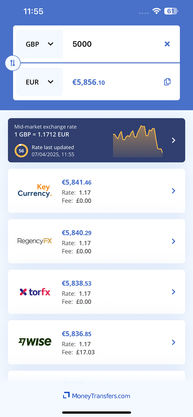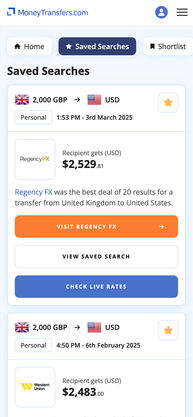Different Ways to Send Money to a Bank Account in 2025
Sending money to a bank account should be simple, but there are lots of different ways it can be done. You can send money online, in person, or even through a third party. With all these options, it’s difficult to know which one is best for you.
In this guide, we’ve broken down the main ways you can send money to a bank account into easy to follow steps. Find out how to transfer money between bank accounts using ACH transfers, mobile payment apps, transfer providers, and more.
Search Now & Save On Your Transfer
How to send money to a bank account domestically
Most bank transfers can be made online. If you prefer, you may be able to start a transfer in person at your local branch, or over the phone. You can transfer money to a bank account via:
ACH bank transfer
Domestic wire transfer
Debit or credit card
Payment app
Check
Money order
Cash deposit
ACH bank transfer
Banks in the US have traditionally charged for making an external transfer to another bank account by ACH payment. These days, fees are low, and sometimes banks will make ACH transfers free of charge. They are quite a slow method, usually taking three to five business days to process, so you may find it more useful to make a wire transfer or send money using a payment app.
ACH payments are processed electronically, so there’s no need to visit a bank to make one. They’re generally split into two types, an ACH debit payment and an ACH credit payment.
How to make an ACH debit payment
ACH debits, also called ‘pull’ payments, allow you to authorize an organization to automatically take an agreed amount of money from your bank account. Payments like these are often used for recurring external transfers, like regular bills, like a mortgage, rent, or utilities.
Request an ACH debit form
Complete the form
Confirm the dates
Check the details
Submit
How to make an ACH credit payment
ACH credit payments, sometimes called ‘push’ payments, are bank transfers that need your recipient’s bank details to complete. These payments are most often used to pay bills, send money to friends and family, or make donations to charity.
Log in
Go to payments
Enter the details
Check the details
Submit
Domestic wire transfer
Wire transfers are quicker than ACH transfers, but considerably more expensive. Fees average around $25 for sending a domestic bank wire, and you may also need to pay a fee for receiving a transfer by bank wire. Receiving a bank wire can sometimes cost up to $15.
If you’re looking for a cheaper way of sending money from one bank account to another, you may be better off using a payment app.
How to make a domestic wire transfer
You can make a domestic wire transfer directly at your bank, online through your bank, or using a specialist transfer provider. While bank wires are always one of the more expensive ways to transfer money to a bank account, transfer providers like Wise and XE offer cheaper wires than most banks.
Find a provider
Check the fees
Complete the wire transfer form
Check the details
Submit
Keep your wire transfer receipt
If you’re making a wire transfer, it’s important to make sure you get a receipt. This could be an electronic receipt sent to your email address, or a printed receipt given to you at your local branch.
Debit or credit card
In some cases, you can transfer money directly to a bank account using your debit or credit card. You can do this by using a specialist money transfer provider, or by using a mobile app like PayPal, Xoom, or Venmo.
Debit cards are often a relatively cheap way of sending money to someone else’s bank account. Credit cards on the other hand are quite expensive.
How to send money using a debit or credit card
In some cases, you’ll need to deposit money into your account with your card before you can transfer money. This is the case with apps like PayPal. With most transfer providers, you’ll need to state how you’d like to pay when you enter the payment details.
The exact method for sending money using a debit or credit card will depend on the method you choose, but generally:
Log in to your account
Enter the payment screen
Enter the required details
Check the details
Submit
PayPal doesn’t send to your recipient’s bank account directly
PayPal will transfer money to your recipient’s PayPal account, rather than directly to their bank account. When they receive the money in PayPal, they’ll be able to withdraw the money and deposit it in their linked bank account. This process usually takes around one business day, but can take up to five business days depending on their bank’s clearing process.
Payment app
Payment apps are some of the easiest, fastest ways to transfer money to a bank account. One of the most well-known is Zelle. If your recipient is enrolled, and their bank uses Zelle to transfer money, you can use it to make instant transfers directly to their bank account.
You can also use other money transfer apps like PayPal, Xoom, or various other specialist transfer apps to send money to someone else’s bank account. The process is largely the same.
How to send money using a payment app
Some payment apps need you to deposit money into your in-app account before you can send it to a bank account. These apps usually process email money transfers. Others, like Zelle, allow you to transfer money directly from your connected bank account to another. Here’s how you can send money to a bank account using an app like Zelle:
Download or open the app
Enter the payment screen
Enter the required details
Check the details
Submit
Check
Electronic transfers are quicker and often more convenient, but you can still make payments via paper check. Checks often rely on the postal service to be delivered on time, but they’re much more secure than sending cash in the post.
One advantage of checks is that they’re relatively easy to cancel. It’s a good idea to keep in touch with your recipient by other means, like phone or email, to make sure they’ve received your payment and they can cash your check. If they haven’t received it within a week, it might be a good idea to cancel your check and send another to make sure it gets to the correct person.
How to send money by check
To write a check, you’ll need a checkbook.
Fill out the check
Write a memo (optional)
Check the details
Post the check
Money order
Money orders are a useful alternative to checks. They’re easier to track, and can be replaced for a fee if they’re lost or stolen. You’ll need to go to a specialist money order company to buy and complete one. They’ll then send it to your recipient.
Money orders can only be sent for a maximum of $1,000, so they’re less useful if you’d like to send large amounts of money.
How to send a domestic money order
A money order is purchased for a prepaid amount and used as a payment method. They’re more flexible than checks as they never go out of date.
Go to a money order company
Fill out the money order
Check the details
Pay the total, plus any fees
Keep the receipt
Cash deposit
Some banks allow you to make a cash deposit in your recipient’s branch, but others don’t. For example, Wells Fargo does not allow any cash deposits to be made in person by anyone other than the named account holder.
However, a more convenient way to transfer cash is with a money transfer provider. Transfer services like Instarem, Western Union, and WorldRemit can transfer money to someone via cash deposit, which they can then pick up and deposit in their bank account.
How to send a cash deposit to someone
If your recipient’s bank account is local to you, you may be able to make a cash deposit with the bank in person. Otherwise, it’s best to use a money transfer provider.
Find a transfer provider
Register with the provider
Open the provider’s app or go to a location in person
Fill in the recipient’s details
Check the details
Send the money
How to send money to an overseas bank account
There are various ways you can transfer money to bank accounts around the world: by visiting the bank, sending money online, or over the phone.
If you choose to send money directly from your bank account to an overseas bank account through internet banking, you need to follow the steps below. While the exact process may vary depending on the bank you are sending money from, some basic steps remain the same.
Log in
Go to payments
Enter the details
Select the sending account
Confirm the currency and amount
Check the details
Submit
Depending on the financial institution you are sending money from, you may need to visit the branch in person to make an overseas transfer. You will need to provide your identification, bank account details, and the recipient’s details.
You can even use cell phone banking to make an international bank transfer which is helpful for those who do not wish to use online banking or visit a branch. In some cases, you can contact your bank branch and request assistance with the transfer.
In this case, you will need to have your bank information and answers to your security questions handy, in order to verify your identity.
How do international bank transfers work?
International bank transfers are made using the SWIFT network. This network permits the transference of money from your bank account to another bank account in another corner of the world.
Whenever someone makes an international transfer request, it is processed at the initiating bank and then sent to one or more banks within the overlapping SWIFT networks, until it reaches the destination bank account.
Each international bank transfer may involve 1 - 3 intermediary or correspondent banks. These banks act as links that connect to the recipient’s bank. Your money transfer instructions pass through these banks on the way to the destination bank account. Each of the intermediary banks may levy a fee, which is deducted from the transfer amount, reducing the final of the funds received.
It must be noted that although there are other services like CHIPS and Fedwire, SWIFT is the most widely used network owing to its huge membership and robust coding system.
Pros
Cons
Refunds
Getting a refund on your transfer can be difficult. A refund will not always be possible, and if it is, will usually take up around 5 - 10 business days to complete, but it all depends on your provider.
The difficulty of refunds is one of the main reasons why it’s so important to check the details of your transfer before sending any money.
Some money transfer providers, like Wise, allow you to cancel your transfer within 30 minutes of making it. This allows you to claim a full refund.
Fees
Sending money to a domestic bank account is quite cheap, usually free. But, this depends on your payment method. Credit card payments and wire transfers can be quite expensive.
International transfers are altogether different. Usually, sending money to a bank account overseas via bank transfer with your local branch is very expensive. Your bank will usually only be able to send money internationally by wire transfer, which is more expensive than most other methods.
Fixed fees
There are often fixed fees for international wire transfers, ranging from $20 to $50. There is a fee for both ingoing and outgoing bank transfers; for example, Bank of America and Citibank charge between $35 and $45, Chase charges $40 to $50 and US Bank charges $50 per international bank transfer.
Exchange rate markups
Most banks will add a markup to the exchange rate when you exchange money with them. These are considered ‘hidden fees’, as they’re rarely labeled openly. It’s a good idea to check the mid market exchange rate before you send any money to make sure you’re getting a good deal. You can use our currency converter to check in advance.
Avoiding fees
If you’d like to transfer funds overseas to a bank account, you may find a better deal with a money transfer provider. They offer lower fees and better exchange rates than most high street banks, and can often send your money faster as well.
Things to consider
Before transferring any money, it’s important to consider the following:
Cost
Exchange rates
Speed
Transfer limits
Regulations
Safety
Check your provider is regulated
You should only ever use regulated providers to transfer money. If a provider is not regulated, it’s likely to be a scam.
Remember: We will only ever recommend regulated financial institutions.
Alternative ways to transfer money
Sending money directly from one bank to another isn’t the only way you can transfer money. You can also use:
Money transfer providers
P2P payment apps
Money orders
A cash deposit
In most cases, these options can also be used for a bank to bank transfer.
Sending money to a bank account - there’s more ways than one
Sending money between bank accounts is one of the most common ways of making payments. But you don’t need to stick with the slow ACH bank transfers or the expensive wire transfers.
These days, money transfer providers and P2P payment apps are considerably cheaper, faster, and better ways of sending money. They can be used in their own right, or they can be used to transfer money between bank accounts easily and efficiently.
FAQs
What’s the best way to send money to a bank account?
Why was my bank account transfer declined?
How long does an international wire transfer take?
Can I send money to friends and family via bank transfer?
Can I send money to a bank account using a credit union?
Related content
Related Content


Contributors
.jpg)
Frank Day








